Censorship in the Paperback Age
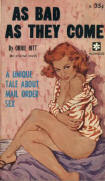
The most popular vintage paperback web sites on the internet are those that deal in "Sleaze" from the 1960's. The word, according to Webster, means cheap, vulgar or shoddy. I'd define it, in this context, as using sensationalism to explore the borders of what is considered acceptable in the current literary environment. The closer a book, topic or cover gets to that line, the "sleazier" it is. But in the 60's, these books meant much, much more to paperback houses, which had fought long and hard for more lenient First Amendment rights. Only a few short years before, such things were not allowed in American society; and that, I think, is the real basis behind the popularity of those books. Such writings were once banned. And there is nothing more intoxicatingly irresistible than a banned book.
It has always been the opinion of the U.S. government that it is the duty of the individual community to protect its members from pornography and other problematic material. This was especially evident in movie distribution in the 30’s and 40's. A film would travel around the country, but in each town the first individuals to view it would be the city censors. More and more, the contents of a can of film would be clipped as it traveled from place to place. (Parts of the “Our Gang” comedies, for example, were often "snipped" by communities in segregated southern states, deleting portions showing black and white kids in the same schoolroom.)
And so it was that a book was allowed on a library shelf in one town, but was banned in a town a few miles away. (It’s still that way today, by the way. There are many towns in the U.S. where it’s against “community standards” to sell a Playboy magazine.)
The first “win” for 1st Amendment book advocates came in 1933 when publishers of James Joyce’s Ulysses challenged the laws espoused by Anthony Comstock in 1872. These laws, among other things, made it a federal crime to ship obscene material through the U.S. mail. The Court ruled in "Ulysses" that a book had to be considered obscene as a “complete work,” rather than by singling out passages. Overall, however, the case actually had minimal effect on the publishing industry.
The standards implemented by the
Post Office, as well as by censors in New York, where the books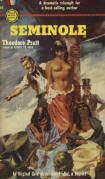 were published, made it all an astonishing game of legal cat and
mouse. The trick for
paperback houses was to test the boundaries of what was considered
“descent,” and not cross that line. In the overall scheme, you could
allude to the sex act as long as you didn’t actually describe it. You
could be provocative, but not too provocative. You could claim
to treat the subject of sex openly as long as you didn't really do
it. Nudity was okay, as long as you didn’t show too much. (One odd
exception was racial. Pictures of white women could not display a
bare breast or nipple, but women of other races seemed fair game. Also, if
the cover depicted the woman as "art," such as a picture-in-a-picture, it
might appease the censors. These were only a couple of the seemingly unfathomable enigmas of the times.)
were published, made it all an astonishing game of legal cat and
mouse. The trick for
paperback houses was to test the boundaries of what was considered
“descent,” and not cross that line. In the overall scheme, you could
allude to the sex act as long as you didn’t actually describe it. You
could be provocative, but not too provocative. You could claim
to treat the subject of sex openly as long as you didn't really do
it. Nudity was okay, as long as you didn’t show too much. (One odd
exception was racial. Pictures of white women could not display a
bare breast or nipple, but women of other races seemed fair game. Also, if
the cover depicted the woman as "art," such as a picture-in-a-picture, it
might appease the censors. These were only a couple of the seemingly unfathomable enigmas of the times.)
In the late 40’s, and
especially the early 50’s, there was more and more community outrage
directed toward the paperback industry. Titles that were sold for the very
steep price of three dollars were now available to everyone for a quarter,
and many “objectionable” books were breaking the 100,000 printing level.
Worse, the cover art was often pointedly provocative. But, while
communities found it easy to ban a
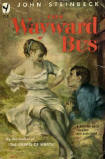 book
in a school or library, it was much more difficult to do so on the
newsstand. They turned to the federal government for help.
book
in a school or library, it was much more difficult to do so on the
newsstand. They turned to the federal government for help.
In May 1952, Congress convened The House of Representatives Select Committee on Current Pornographic Materials that specifically targeted paperbacks.
Titles single out by the committee included Shulman’s The Amboy Dukes,
Caldwell’s God’s Little Acre, John Faulkner’s Dollar Cotton,
Weidman’s I Can Get It for You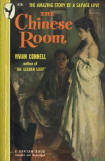 Wholesale, Connell’s The
Chinese
Room, and Steinbeck’s The Wayward Bus (there were 60 paperback
titles in all declared “objectionable”). The list was banned in many
communities, but when challenged by the lawyers of the major paperback
houses, the bannings in large metropolitan areas would not hold
up in court unless it was shown that a true representation of the entire
community had declared such works obscene. And when a city's attorney
brought a pornography indictment against a publisher or author in court,
it was often thrown out if everyone in the jury had not read “the entire
work” as specified in the Ulysses case.
Wholesale, Connell’s The
Chinese
Room, and Steinbeck’s The Wayward Bus (there were 60 paperback
titles in all declared “objectionable”). The list was banned in many
communities, but when challenged by the lawyers of the major paperback
houses, the bannings in large metropolitan areas would not hold
up in court unless it was shown that a true representation of the entire
community had declared such works obscene. And when a city's attorney
brought a pornography indictment against a publisher or author in court,
it was often thrown out if everyone in the jury had not read “the entire
work” as specified in the Ulysses case.
It
all came to a head in May 1959, when Grove Press printed a hardcover
“unexpurgated” edition of D.H. Lawrence’s Lady Chatterley’s Lover.
Postal inspectors immediately seized shipments of the book, saying that
the work was “obscene, lewd, lascivious, indecent and filthy in character,
and that it appealed to the prurient interest.” That was a term
which had been defined as “lustful” by a previous court; but in this case,
Judge Frederick Van Pelt Bryan ruled that it meant “a shameful or morbid
interest in sex,” and that the “whole book” did not dwell on this topic.
Ergo, Lady Chatterly was NOT
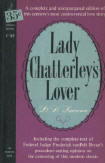 obscene.
obscene.
The work was out of copyright in the United States, and was therefore in the public domain. NAL had published several printings of the expurgated version, and it fought briefly with Dell for the honor of printing the whole volume. But within 8 days of the decision, Pocket Book had the first copies on the street, and would eventually produce more than a million. The book included the text of Bryan's court decision.
Now, just as long as a work could be shown to have any moral content other than “shameful or morbid” sex, it would be almost impossible for the government to deem the work obscene. The dam burst. Much of the U.S. public seemed to be starving for something that it had been denied for almost two centuries, and the flood of overtly sexual books (just so long as they dwelt with some other issue as well) was welcomed by huge numbers of readers.
Did the pendulum swing too far the other way? Many, many "decent Americans" certainly thought it did. Lots of works could (and would) be considered obscene by many communities. But usually, it was simply too hard for those who objected to distribution of the books on moral grounds to convince a majority of community members to deny themselves the opportunity to judge the works firsthand. Also, objections of "endangering our youth" were somewhat quelled when publishers deemed the works “For Adults Only.” And anyway, people could always simply order them through the mail. It was legal now.
The result of all of this is what you will see in the "Sleaze" section of the database (though you certainly wouldn't see most of those books in your public library). Just as always, the most popular works were often the most outrageous, the most provocative, and the most controversial (to say nothing of "cheap, vulgar and shoddy"). And just as always, the only rule was “how far can you go” without crossing the line. But that line had just been moved a long, long way to the left.
(Some of the information in this article was taken from Two Bit Culture, by Kenneth C. Davis. See the Reference Section.)